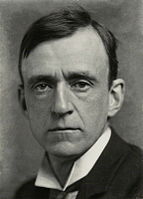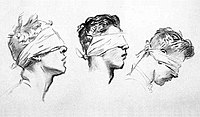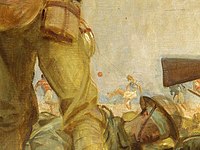Gassed

|
| Gassed |
|---|
| John Singer Sargent , 1919 |
| Oil on canvas |
| 231 × 611 cm |
| Imperial War Museum in London |
Gassed (Gasvergiftet) is a painting by John Singer Sargent (1856-1925) in 1919. It is now in the Imperial War Museum in London , showing soldiers of the British Expeditionary Force after a poison gas attack on German troops in the First World War . John Singer Sargent, a prominent American portrait - painter , made the painting in 1919 on behalf of the British Ministry of Information (Ministry of Information) at. The painting is one of the most important depictions of the war and its aftermath for the British public.
prehistory
In 1918 the British Ministry of Information commissioned the painter John Singer Sargent to produce the central painting of a planned memorial hall ( Hall of Remembrance ) for the First World War. The subject of his work was to be Anglo-American cooperation in the world war. Other artists were also commissioned to document the war in pictures for the memorial hall, including Percy Wyndham Lewis , Stanley Spencer , Christopher Nevinson , Paul Nash and Henry Tonks . In July 1918, Sargent traveled with Henry Tonks, who had previously served in the Royal Army Medical Corps, to France on the Western Front .
Southwest of the town of Arras in the Pas-de-Calais department in northern France, Sargent and Tonks experienced the dramatic consequences of a gas attack in August 1918. Near the small village of Bailleulval there was a treatment center at Le Bac du Sud , which consisted of several huts and a few tents. In the evening, Sargent and Tonks were able to observe how paramedics repeatedly led groups of around six gas victims to the treatment center. The wounded, who eventually numbered several hundred, sat or lay down on the grass. The blinded soldiers apparently suffered from great pain, especially in their eyes, which were bandaged with a piece of cloth. Sargent was very moved by the scene and immediately took numerous notes.
Preparatory work and completion
Sargent decided to make this harrowing event the subject of his large-format work. The Information Department's War Memorials Committee, which had been entrusted with the selection of the paintings, approved the change of theme. Sargent worked on the painting from late 1918 to March 1919 in his studio in Fulham, London . To this end, he made numerous studies with charcoal on paper, in which he dealt with details and the overall composition. The working title of the painting was Gassed Soldiers .
Finally, Sargent made a small-format oil sketch that already combined all the essential elements of the painting. This design was sold at Christie's auction house for £ 162,050 in 2003 . Sargent had finished the painting in March 1919. It was subsequently exhibited at the Royal Academy of Arts in London. Due to a lack of funding, the plan for the memorial hall was dropped after the end of the war and the work was housed in the Imperial War Museum together with other paintings intended for the memorial hall. Sargent was paid £ 300 for his painting at the time, about £ 14,000 today.
Image description
The large-format painting is 6.11 m wide and 2.31 m high, so that the people in the foreground are depicted almost life-size. The painting technique is oil painting with oil paint on canvas . The painting is very skilful and technically adept with loose brushstrokes. Three groups of three soldiers form the center of the painting. A paramedic and another soldier, both of whom have turned away from the viewer, lead the gas victims along a path through the empty landscape. The path leads on a wooden walkway to a medical tent, the ropes of which can be seen on the right edge of the picture. In the individual groups of three, the soldiers hold on to the shoulder of the person in front. The eyes of the injured are bandaged with blindfolds. Four of the nine soldiers do not wear a helmet on their heads. One of the wounded has raised his leg sharply on the step to the wooden walkway because he cannot estimate the height of the obstacle.
In the foreground, more wounded are sitting or lying around. A soldier drinks from a water bottle. Some of the people lying down could also be dead. In the right background you can see eight more gas victims who are led by two paramedics. A soldier has leaned forward and is vomiting. The rising moon is shown to the left of this group. In the background uninjured soldiers are playing soccer. The players seem to ignore the ranks of wounded comrades. The second group and the soccer players in the background are illuminated from the right by the evening sun. The soldiers in the foreground are apparently in the shadow of the medical tent. The evening light bathes the whole scene in a mild orange light.
Sargent draws the viewer's gaze to the tactile relationships between the defenseless men. There is a faint glimmer of hope for those who suffer when they are led to the medical tent, but the overall impression is marked by loss and suffering, which is reinforced by the stooped posture of the men. The contrast to the apparently carefree football players is underlined by the fact that they have stripped of their uniform, whereas the wounded still wear almost all of their clothing and equipment.
background
Gassed is not representative of the complete works of John Singer Sargent. The portrayal of loss and suffering was not one of the typical subjects of his work up to this point . At the turn of the 19th and 20th centuries he was a famous and expensive portrait painter. Although Sargent was repeatedly praised for his technical skills, his subjects and his painting style also earned him the charge of superficiality. Therefore the calm and dignified portrayal of the war victims is unusual for his work. On the western front, Sargent painted other pictures. These are in watercolors and do not show the horror of war with the expressiveness and urgency that Gassed does . Sargent was 62 years old at the time the painting was completed, so the picture can be counted among his late works.
The painting is strong evidence to the handling of the gas victims, the lack of protection against chemical weapons and the effects and extent of a gas attack: In the by the trench warfare ravaged landscape behind the western front boardwalks leading to treatment sites with tents. The soldiers were evidently exposed to gas attacks again and again, as some of the gas victims depicted carry gas masks in pockets around their necks . Protective clothing against contact poisons, however, is missing. Gas attacks led to high losses at certain points, as the painting illustrates. In addition, the paramedics were overwhelmed by the large number of victims. The wounded are apparently lying or sitting on the floor without further medical attention. However, after four years of war, the soldiers were numb to the multiple suffering - the football game continues.
Sargent and Tonks had apparently witnessed the aftermath of the German gas attack on the 99th Brigade of the 2nd Infantry Division and the 8th Brigade of the 3rd Infantry Division of the British Army during the Second Battle of Arras. In this attack was mustard gas ( mustard gas ) is used, a chemical warfare agent, which decomposes the tissue of the skin and the respiratory tract. The persistent contact poison penetrates unnoticed into the airways and through clothing into the skin and takes a few hours to take effect. Injuries similar to burns or chemical burns occur, which lead to skin blisters , vomiting , occasionally going blind and occasionally suffocation . Contact with mustard gas is rarely fatal, but it causes excruciating injuries and severe pain to the person concerned. In the First World War, however, the chances of recovery were better than in comparison to wounds from gunshot wounds. The year 1918 was the climax of the gas war. The poison gases were exposed with grenades by the artillery . On average, every third shell was filled with chemical warfare agents. Mask breakers were used along with the chemical warfare agents . These nasal and throat agents exerted a strong irritant effect on the respiratory tract, so that the persons affected had to take off the gas mask and were exposed to the effects of the actual agents.
reception
Gassed was voted Picture of the Year by the Royal Academy of Arts in 1919. But the painting was not without controversy. Some critics thought it was unrealistic, pathetic and overly heroic. However, Winston Churchill said that the painting, because of its ingenious representation and painful meaning, illustrates the obvious shaking of British national consciousness by the events of the war. The writer Virginia Woolf was generally critical of Gassed , but stated that this painting "has finally hit the nerve of protest or perhaps humanity ". They particularly disturbed theatrical details such as the exaggeratedly raised leg of the soldier on the step.
From 2016 to 2018, the painting went on an extensive tour through the United States and generated great media interest there and in Great Britain. The New York Times described the painting as "monumental", the Daily Mail a "masterpiece", the Daily Telegraph described it as "great", the Guardian as "extraordinary" and the Associated Press as "epic". The painting has been shown at the Pennsylvania Academy of the Fine Arts and the Wylie Gallery of the National World War I Museum and Memorial in Kansas City . Gassed is considered one of the most important depictions of war in modern times in the English-speaking world.
literature
- Delphi Classics (Ed.): Masters of Art: John Singer Sargent. Delphi Publishing, Hastings 2015, ISBN 9781786564870 .
- Marion Girard: A Strange and Formidable Weapon: British Responses to World War I Poison Gas. University of Nebraska Press, Lincoln 2008, ISBN 9780803222236 , pp. 178-180.
Web links
Individual evidence
- ↑ https://www.iwm.org.uk/history/10-incredible-paintings-from-the-hall-of-remembrance-series (July 18, 2018)
- ↑ a b https://www.christies.com/LotFinder/lot_details.aspx?intObjectID=4112681 (July 16, 2018)
- ↑ https://www.iwm.org.uk/history/how-the-british-government-sponsored-the-arts-in-the-first-world-war (July 18, 2018)
- ↑ https://www.iwm.org.uk/collections/item/object/20780 (July 16, 2018)
- ↑ https://www.iwm.org.uk/collections/item/object/23722 (August 16, 2018)
- ↑ a b c https://arthistoryunstuffed.com/official-artists-of-the-great-war-john-singer-sargent-part-two/ (July 14, 2018)
- ↑ https://www.independent.co.uk/arts-entertainment/art/great-works/great-works-gassed-1919-by-john-singer-sargent-8637923.html (July 14, 2018)
- ↑ a b c d https://www.theworldwar.org/explore/exhibitions/past-exhibitions/john-singer-sargent-gassed (July 14, 2018)
- ↑ https://chronicle250.com/1919 (July 20, 2018)
- ↑ http://www.centenarynews.com/article/world-war-i-and-american-art---centennial-exhibition-launching-in-philadelphia- (July 14, 2018)















